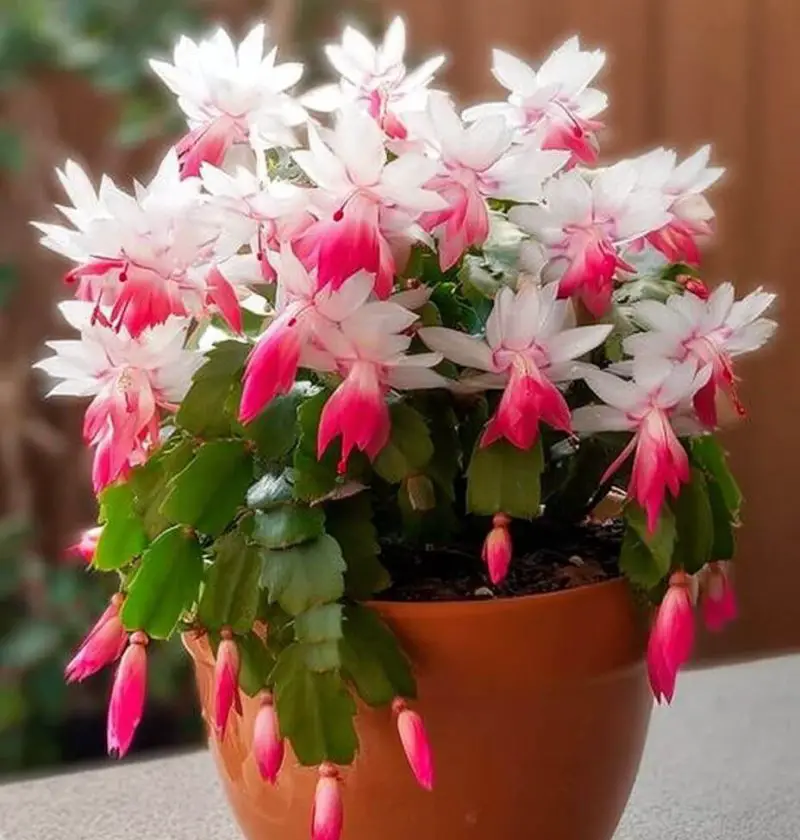Save This Recipe
Alright, let’s get one thing straight—I’m no master gardener with a greenhouse and misting system and perfect nails. I’m just a lady who once bought a sad little Christmas cactus on clearance the week after New Year’s and somehow kept it alive… and then blooming. In July.
Since then, I’ve had a soft spot for these funky little plants. They’re kind of like your quirky aunt—bright, full of personality, shows up once a year in glitter, and somehow manages to surprise you every time.
If you’ve ever brought one home, stuck it on the windowsill, and watched it wither into a spindly mess by Valentine’s Day—don’t worry. You’re not alone. But I promise, with a few simple tweaks, you can grow a Christmas cactus that not only survives the holidays but becomes a year-round house guest you actually enjoy.
Let’s talk about it.
First Things First: The Pot Situation
Here’s the deal: the pot matters, but it doesn’t need to be fancy. Just make sure it has a drainage hole. That’s it. If water can’t drain, the roots get soggy, and your cactus throws a fit (read: rots and dies).
I’ve got mine in an old ceramic pot I found at a thrift store—it’s chipped, sure, but it’s cute and gets the job done. And if you find a pot you love that doesn’t have drainage? No problem. Just stick the plant in a plastic nursery pot inside your pretty one, and take it out to water. Boom. Done.
Dirt, But Make It Smart
Don’t overthink the soil. Just remember: the cactus doesn’t want to sit in mud. It wants something light, fluffy, and a little gritty—like a good muffin batter, not cookie dough.
I mix:
-
A couple scoops of peat moss or coco coir
-
A scoop of perlite (that white stuff that looks like packing peanuts)
-
A scoop of coarse sand
If that’s too much trouble, just grab a bag of cactus or orchid mix at the store and call it a day. No one’s judging you.
Light: Goldilocks Style
Too much sun? It burns.
Too little? It pouts.
Just right? Bright, indirect light.
Stick it near a window that gets morning sun or filtered afternoon light. Mine sits by the kitchen sink under a lace curtain, and she’s perfectly content. If your plant starts turning reddish or looking crispy, it’s probably getting sunburned. Move it back a bit.
Think cozy—not beach vacation.
Watering Without Drama
This part makes people nervous, but it’s easier than you think.
Here’s my rule: I water when the top inch of soil feels dry. I just stick my finger in and check. If it’s dry, I water until it starts to drain out the bottom. Then I leave it alone.
Things I don’t do:
-
Use a moisture meter
-
Set a timer
-
Panic
During bloom time, I mist it now and then, or I set a little dish of water nearby. Nothing wild. Just enough to keep it happy.
Feed Me, Maybe?
Your Christmas cactus does like a snack now and then—but it’s not a teenager. It doesn’t need constant fuel.
From spring through early fall, I give it a little diluted houseplant fertilizer once or twice a month. That’s it. Half strength. No fancy formulas. No spreadsheets.
And once it starts cooling down and heading into rest mode? I stop. Let it nap. Let yourself nap.
Trimming: Yes, You Should
After it’s done blooming, give it a little haircut. Trust me, it won’t mind.
Just snip off a few of the outer segments—where the plant looks leggy or lopsided. Use scissors, or if you’re like me, twist ‘em off with your fingers while you’re watching “The Great British Bake Off.”
You can even stick the cuttings in soil and make baby plants. I’ve got three growing in old yogurt cups on my windowsill right now.
The Weird Little Nap It Needs
Okay, so here’s the part that feels like you’re doing something wrong—but you’re not. In the fall (like, October-ish), your cactus needs a break. It’s not dying. It’s just tired. Same.
Here’s what I do:
-
Move it to a cooler room (like 50°F-ish).
-
Give it way less water.
-
Keep it in the dark for at least 12 hours a day (closets work great).
Do that for about 6 weeks. Then bring it back out, water it like normal, and bam—buds. Little tiny baby blooms, ready to party.
Bug Drama (Let’s Keep It Low)
Keep an eye out for mealybugs and spider mites. They show up like uninvited cousins at Thanksgiving. You’ll see little white fluff or fine webbing.
If that happens, wipe ‘em off gently and spray with neem oil or insecticidal soap. I do this once a month anyway, just to keep things clean and drama-free.
A Final Word From a Cactus Convert
Here’s the thing I wish someone had told me when I first brought home a Christmas cactus: it doesn’t have to be fussy. It’s not one of those plants that drops dead the minute you look at it funny. It just needs a little rhythm—a little attention now and then—and the freedom to do its own thing.
And when it blooms? Oh, honey. It’s like waking up one morning to fresh snow and realizing you still have coffee in the pot. Pure magic.
So go ahead—give that cactus a real shot. Stick it in a cozy pot, water it when it’s thirsty, give it a nap when it’s tired. Before you know it, it’ll be blooming like nobody’s business.
And if it doesn’t work out the first time? Try again. Plants are patient. You should be too.
Got a cactus story? A bloom in the middle of July? A plant that came back from the dead? I’d love to hear about it. Leave a comment or send me a note—especially if your cactus has a name (mine’s named Dolores).

